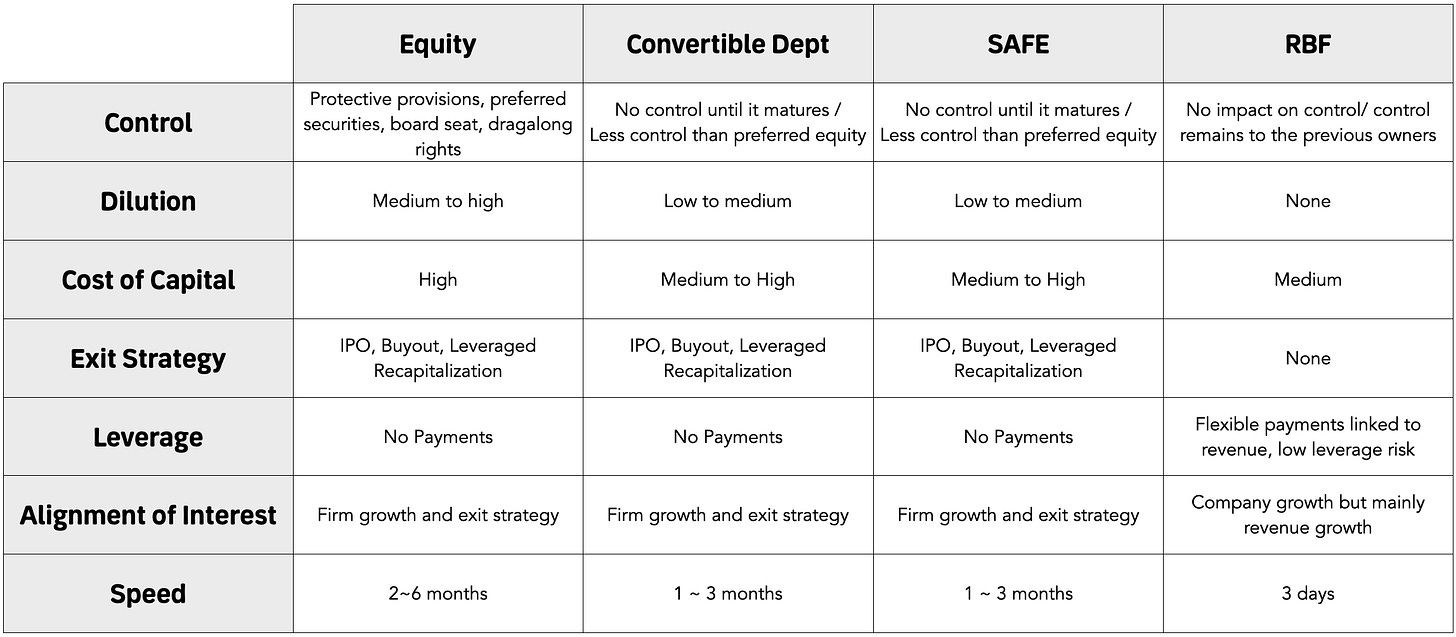Picking the right financing instrument for your business

As an entrepreneur, picking the right financing instrument is critical to a startup’s success, and founders should be thinking about which one is right for their company. Don’t just go with the easy option or what your lawyer tells you to do – put some thought into it, and you’ll be better off in the long run.
There are three main types of financing instruments for startups: Equity, Convertible Notes, and SAFEs. Additionally, Revenue Based Financing. Each type of financing has its own pros and cons, and the right one for your company depends on your specific situation.
Equity
Equity is a type of security that represents ownership in a company. There are two types of equity; (1) Common equity, and (2) Preferred equity.
Common equity is the most basic form of stock and is what most people think of when they think of stocks and shares. When you buy common equity, you are buying a piece of the company and are entitled to a portion of the company’s assets and profits.
It is also the riskiest form of investment, as common shareholders are last in line to receive payments in the event of a liquidation. As a founder, you hold this type of stock. Your employees, executives, and advisors also hold this type of stock or have options to purchase it.
There are many benefits of common equity, including:
It can provide a source of funding for the company
It gives employees, executives, and advisors a financial stake in the company's success.
It can help attract and retain talented employees (equity compensation).
It incentivizes these individuals to work hard and help the company grow.
There are a few drawbacks of common equity, including:
It can be difficult to value, and it can be diluted if the company raises money
Common equity holders may be last in line to receive payments if the company is sold or goes public.
Common shareholders may have limited voting rights
Common equity holders may be liable for taxes on any gains
Overall, common equity is a great way to give employees, executives, and advisors a financial stake in the company's success. This type of equity can incentivize these individuals to work hard and help the company grow.
Preferred equity is a more senior form of investment, and represents a claim on a company's assets that is senior to that of common shareholders. It gives investors certain rights and privileges that are not available to common shareholders. For example;
Preferred equity gives investors a higher claim on the company's assets and earnings than common equity holders. This means that if the company is sold or goes public, preferred equity holders will receive their money back before common equity holders.
Preferred equity also typically comes with preference when it comes to dividends. This means that if the company declares dividends, preferred equity holders will receive their share before common equity holders.
Finally, preferred equity gives investors some level of control over the company. This is because preferred equity holders typically have preferential voting rights, meaning they have more say in how the company is run.
Convertible Note
A convertible note is a type of debt (it often includes provisions that prevent startups from repaying. I think no startup has ever repaid it up to now) that converts into equity, typically at a discount, after a period of time, or when a company reaches certain milestones. This type of investment is popular with startups because it allows them to raise capital without giving up equity in the early stages of their company’s development. Convertible notes are also attractive to investors because they offer the potential for a higher return on investment than traditional debt instruments.
The key terms of a convertible note include the conversion price, conversion discount, and maturity date.
💲 The conversion price is the price per share of common stock that the investor will receive when the debt converts to equity.
🏷 The conversion discount is the percentage by which the conversion price will be reduced. For example, if an investor holds a convertible note with a 20% conversion discount and the company’s stock is trading at $1.00 per share when the debt converts, the investor will receive 20% more shares than if they had invested in the stock at the current price.
📅 The maturity date is the date at which the debt must be repaid in full if it has not already been converted to equity. Convertible notes are typically issued with a 1- to 5-year maturity.
There are a lot of different variations of convertible notes, but most of these variations involve a valuation cap. If you don't have a valuation cap, you're essentially saying that the convertible note will convert at the valuation of your next round. If you have a valuation cap, you're saying that the convertible note will convert at the lower of either the valuation of your next round or the valuation cap. A valuation cap is generally a number that the investor and entrepreneur agree on. It is the highest valuation that the convertible note will convert at.
For example, If you invest in a startup using a note with a $3 million cap, and the series A investors decide that the company is worth $6 million and pay $1/share, your note will convert into equity at the $3 million price. This means that you will get twice as many shares as the series A investors for the same price 🎉
SAFE (Simple Agreement for Future Equity)
The SAFE was created by Y Combinator, in 2013 as a way to simplify the process of investing in early-stage startups. The SAFE has become a popular investment tool for angel investors and venture capitalists, as it allows them to invest in a startup without having to negotiate the terms of the investment.
It is an agreement between an investor and a startup that provides the investor with the right to receive equity in the startup at a later date. The SAFE is similar to a convertible note in that it allows the investor to convert their investment into equity at a future date but with a few key differences;
One key difference is that a SAFE does not have an interest rate. This makes SAFE more attractive to early-stage startups who may not be able to afford the interest payments on a convertible note.
Another key difference is that a SAFE does not have a maturity date. This means that the investment is not due and can be left outstanding indefinitely. This can be attractive to startups who are not ready to give up equity just yet.
Lastly, a SAFE can be structured so that it converts into equity at a future equity round, or it can be structured to convert into equity at a predetermined valuation. This flexibility makes SAFE a more attractive investment vehicle for both startups and investors.
While SAFE has some advantages over convertible notes, there are also some drawbacks;
SAFE is not a debt instrument, so it does not have the same tax benefits as a convertible note.
Because SAFE is not a debt instrument, it is not subject to the same regulations as convertible notes. This lack of regulation can be seen as a positive or a negative, depending on your perspective.
It gives investors less control than preferred equity.
SAFEs may have a "most favored nation" (MFN) clause. This clause protects an investor by giving them the same rights and benefits received by later investors if those rights and benefits are more favorable than those originally agreed upon.
Overall, SAFE is a flexible investment tool that can be attractive to both startups and investors. However, it is important to understand the pros and cons of SAFE before using it as part of your investment strategy.
Revenue-Based Financing
Revenue-Based Financing is a type of financing that is becoming increasingly popular with small businesses. RBF is a form of debt financing where the lender provides capital to the borrower in exchange for a percentage of the borrower's future revenue. This type of financing is often used by businesses that are growing quickly and need capital to scale.
RBF is a relatively new funding option, and as such, it can be difficult to find investors who are willing to provide this type of financing. However, there are a few platforms that specialize in RBF, such as WorqCompany and Wayflyer.
RBF is similar to equity financing in that the investor takes on a certain amount of risk in exchange for the potential for a high return. However, unlike equity financing, RBF does not involve giving up any ownership stake in the company.
There are a few key advantages of RBF for companies:
It is a flexible form of financing that can be tailored to the specific needs of the company.
It does not require the company to give up any equity.
It can be a quick and easy way to raise capital.
It aligns the interests of the company and the investor, as both are motivated to grow the company's revenue.
It can be used to finance a wide range of expenses, including research and development, marketing, and expansion.
Which one is better for you?
There are a few key things to consider when trying to decide whether equity, convertible debt, SAFEs, or RBF are the best option for your startup.
One is the stage of your company. If you're just starting out, SAFEs may be the best option since they don't have the same level of dilution as equity. Convertible debt is a good option if you're a bit further along and can offer investors a higher valuation. Equity is generally the best option for later-stage companies.
Another key consideration is the amount of money you're looking to raise. If you're only looking to raise a small amount, SAFEs may be the way to go. Convertible debt is a good option if you're looking to raise a bit more, and equity is the best option for companies that are looking to raise a large amount of money.
Finally, you need to think about what you're willing to give up in order to get the funding you need. SAFEs don't have any dilutive effects, but they also don't have the same upside potential as equity. Convertible debt has some dilutive effects, but it also has the potential to convert into equity at a higher valuation. Equity is the most dilutive option, but it also has the potential to provide the most upside.
So, which is the best option for your startup? It depends on a few key factors. Consider the stage of your company, the amount of money you're looking to raise, and what you're willing to give up in order to get the funding you need.
Disclaimer:
This is not legal advice and I'm not a lawyer. You as the founder are responsible for your own actions and decisions. Please do your own research and consult with a lawyer before taking any action.




